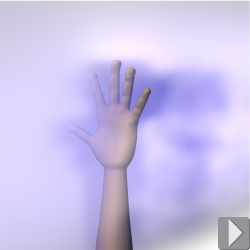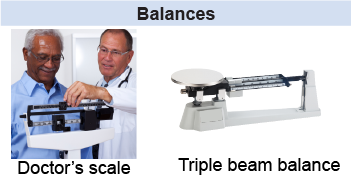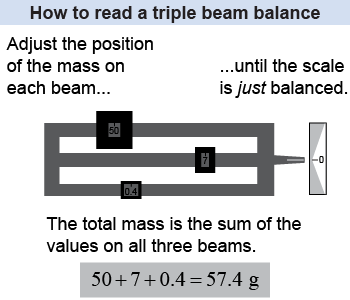|
Matter has mass and takes up space. A solid rock is matter, but so is the air around you. Put your hand out the window of a moving car and you can feel the matter in the air pushing back against your hand as the motion of your hand pushes the air out of the way. 
| 
|
Mass measures the quantity of matter, such as in SI units of grams (g) and kilograms (kg). One kilogram is 1,000 grams, about the mass of the water in a 1 liter bottle. 
|

|
A fist-sized rock and a desk-sized volume of air both have a mass of 1 kg. The mass of a dime is around 1 g. The mass of a car might be 1,000 kg or more. The typical mass of an average adult human ranges from about 50 kg to 100 kg. An elephant might have a mass of 5,000 to 7,000 kg. 
|
 A triple beam balance is a commonly used instrument for measuring mass. Laboratory triple beam balances can usually measure masses between 0.1 g and 500 g. The large scale found in many doctor’s offices is similar but larger, being used to measure weights from 10 to 350 lb (or masses from 4.5 to 159 kg).
A triple beam balance is a commonly used instrument for measuring mass. Laboratory triple beam balances can usually measure masses between 0.1 g and 500 g. The large scale found in many doctor’s offices is similar but larger, being used to measure weights from 10 to 350 lb (or masses from 4.5 to 159 kg). 
|
 The triple beam balance has three sliders, each with a different mass, often 10 g, 1 g, and 0.1 g. The sliders move on the three beams until they balance the mass on the measuring pan. The scale is balanced when the pointer is at the zero setting. It is a good idea to check calibration when first using a balance. The calibration is accurate if the pointer registers zero when the pan is empty and the sliders are all set to zero. To make a measurement, place the mass on the pan. Adjust the position of the highest mass slider to the highest value that does not push the pointer past zero. Then do the same for the middle mass slider. Finally, use the small mass slider to bring the scale into balance. The reading of a triple beam balance is the sum of the masses on all three slider scales.
The triple beam balance has three sliders, each with a different mass, often 10 g, 1 g, and 0.1 g. The sliders move on the three beams until they balance the mass on the measuring pan. The scale is balanced when the pointer is at the zero setting. It is a good idea to check calibration when first using a balance. The calibration is accurate if the pointer registers zero when the pan is empty and the sliders are all set to zero. To make a measurement, place the mass on the pan. Adjust the position of the highest mass slider to the highest value that does not push the pointer past zero. Then do the same for the middle mass slider. Finally, use the small mass slider to bring the scale into balance. The reading of a triple beam balance is the sum of the masses on all three slider scales. 
|
Can an object be massless?
 |
No. All matter has mass. Even atoms and subatomic particles have mass. Objects may be weightless when they are in deep space, out of any gravitational field, but they still have mass. 
|

